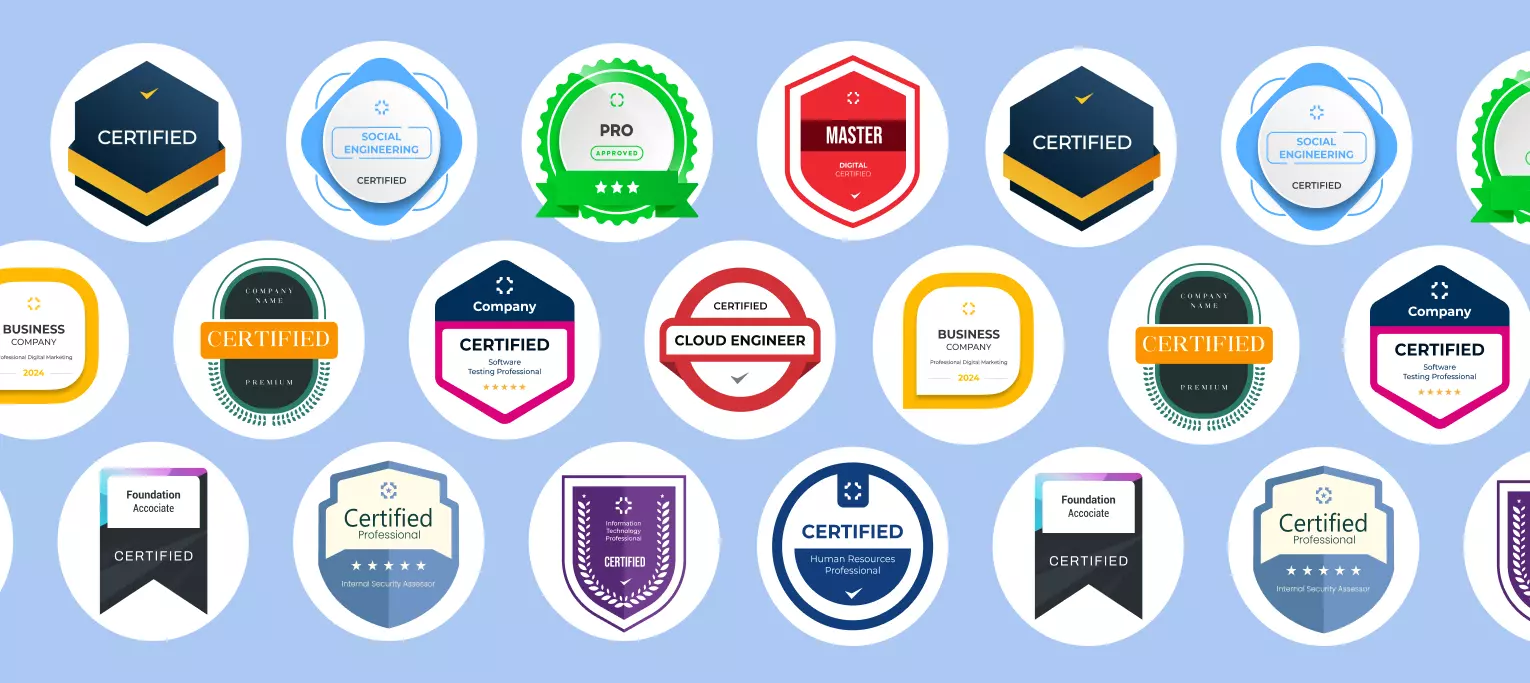Introduction

Digital badges are one of the top trends across various industries in 2023. Digital badges are quickly changing the way businesses run thanks to their widespread usage in a variety of industries, including education, training, marketing, product, compliances, healthcare, and many more. If you're unfamiliar with the idea of digital badges, you might be wondering why there's such a buzz. No matter what amount of experience or even if you are a beginner with digital badges, this blog will provide you a comprehensive knowledge about digital badges. We'll go over the fundamentals of digital badges, such as what they are, how they work, and why they're useful. You will have a thorough knowledge of how digital badges may transform your business and keep you on the leading edge by the time you finish reading this blog.
What are digital badges?

Digital badges, also known as open badges or ebadges, are a means to present your achievements, skills, qualities, in a visually appealing digital format. These are intended to be obtained through a range of learning environments, such as online classes, professional development courses, and even extracurricular activities.
These badges provides a concise way to highlight your skills to potential employers, clients, or coworkers as a validated indicator of your accomplishments. In today's competitive job market, having a digital badge can be a valuable asset, as it can set you apart from others and demonstrate your commitment to learning and professional development.
Furthermore, digital badges are not limited to education or professional development. They can also be used in marketing, human resources management, compliance, product development, and healthcare, among other areas, to enable organizations to identify and recognize skills and accomplishments of their employees or customers.
History of digital badges
Badges in physical form have a long history dating back to the ancient time when they were used to signify membership in various tribes or communities or authority. Since the inception of the military, badges have been used to denote rank and accomplishments, boosting pride and morale among soldiers and officers.

Military badges or army badges served not only as a mark of recognition but also as a way to motivate soldiers to strive for excellence in their duties. Over time, badges became more elaborate and ornate, reflecting the importance placed on these symbols of achievement and honor.
The idea of badges has been applied to other fields, such as education, training, and professional development, as gamification has become more popular recently. Digital badges have grown in popularity as a means of recognizing and showcasing success in multiple domains.
Overall, the development of digital badges has been facilitated by the history of military badges, which have proven to be an effective method for recognizing and rewarding achievements across a range of professions. Digital badges are a powerful way to demonstrate abilities and accomplishments in the digital age, and they can inspire students / employees / customers by leveraging the gamification power.
What are Open Badges?

Open Badges are digital badges that recognize and validate an individual's skills, achievements, or knowledge. Unlike normal digital badges, open badges has a set of important metadata embedded with each badge image which can be verified globally. They are designed to be shareable across multiple platforms and can be earned in various learning environments, such as online courses, professional development programs, or extracurricular activities. Open Badges are based on an open standard initially developed by Mozilla in 2011 and as of January 2017, 1EdTech has taken on the task of spearheading the development of the Open Badges specification and ensuring the long-term viability of the Open Badges ecosystem., allowing anyone to issue, earn, and display them, regardless of their background or institution. They are quickly gaining popularity as a way to showcase one's abilities and accomplishments in the digital age. Certopus is one of a tool that is compliant with open badges standard.
Digital badges in education
The use of digital learning methods is becoming more prevalent in university education, and digital badges represent a fresh and developing approach to encouraging and acknowledging students' progress in their studies. Many universities across the globe have already implemented the issuance process of digital badges for their students and so far getting an overwhelming response from the students as well as employer as mentioned in multiple case studies published by prestigious universities expressing their success with initiatives regarding digital badges.
Digital badges in professional development
The usage of digital badges in professional development initiatives is also prevalent. These badges provides a means of identifying and validating a person's expertise and knowledge in a certain field. For instance, professionals can acquire digital badges by attending a workshop, finishing a certification course, or becoming an expert in a certain field. The professional's career prospects can be improved by adding these badges to their LinkedIn profile, which will highlight their achievements and in addition when it is highlighted on social media, issuing organization of badge gets much required visibility.
Are digital badges worth it?
Digital badges are becoming increasingly important in demonstrating a person's skills and knowledge in a particular field. These badges offer a transparent and verifiable method of validating and recognizing an individual's accomplishments. Digital badges displayed on social media platforms such as LinkedIn can assist professionals in highlighting their expertise and differentiating themselves from others in a competitive job market. Furthermore, digital badges allow employers to quickly assess a candidate's abilities and assist individuals in tracking their professional development progress. For those looking to advance their careers and boost their professional profiles, pursuing programs or learning paths with digital badges can be a worthwhile investment.
LinkedIn badges / LinkedIn skill badges

LinkedIn badges, also known as LinkedIn skill badges, are virtual representations of a LinkedIn user's skills and achievements. These badges are a way to demonstrate one's professional development and expertise in a specific area to potential employers. When a user adds their badge or certificate to their LinkedIn profile, they would be accessible to everyone from their profile’s “Licenses & certifications”. Certopus issued digital badges are directly sharable on LinkedIn and has feature that you can make the recipients auto tag your LinkedIn company page when they add their badge / certificate to their LinkedIn profile.
Creating digital badges

It is quite easy to create digital badges as there are several platforms available to do so, such as Certopus and Credly. Although Credly is the most commonly used platform for issuing digital badges, it can be expensive and offers less value than Certopus. To compare the features and pricing of Certopus and Credly, we have published a blog that can be accessed here: https://blog.certopus.com/credly-vs-certopus-top-credly-alternative.
Future of digital badges
The future of digital badges is promising as they are increasingly being adopted and accepted across industries and educational institutions. The Open Badges standard is a major contributor to the success of digital badges, providing a standardized language and framework for their creation and issuance. Open Badges has evolved through several versions, with the upcoming version being Open Badges 3.0 that offers new features, including the capability to issue badges for related skills and create custom evidence types in a decentralized manner. This standardization and evolution will further enhance the credibility and acceptance of digital badges as a means of showcasing skills and achievements.
Frequently Asked Questions ( FAQ )
How can I make our issued digital badges more valuable to recipient’s potential employers or educational institutions?
You can make your digital badges more valuable to potential employers or educational institutions by ensuring that they provide clear and specific evidence of the skills and achievements that they represent. This can include including descriptions and verifiable evidence of the skills and knowledge demonstrated by the badge earner. Additionally, you can consider partnering with reputable organizations or institutions to offer your badges, which can increase their perceived value and credibility. Make sure issued badges are following open badges standard.
Are there any regulations or guidelines in place for creating and issuing digital badges?
There are currently no formal regulations or strict guidelines in place for creating and issuing digital badges. However, it’s recommend to choose a solution compliant with Open Badges standard like Certopus (https://certopus.com) for creating and issuing badges that are widely accepted and used in the industry. It is important to consider ethical and transparency considerations when creating and issuing badges.
Can digital badges be used as a replacement for traditional degrees or certifications?
Digital badges are a more granular and adaptable approach to highlight specific abilities and accomplishments than traditional degrees or certifications, but they cannot completely replace them. Instead than taking the place of traditional credentials, digital badges can be frequently utilized in supplement to them.
Need more information?
Book a demo to learn more about Certopus for your business use-case, or if you have any questions, please contact us. We would be delighted to assist you. Finally, if you're on social media, follow us to remain informed about our latest developments and to learn more about digital certificates.
Recommended Articles:



